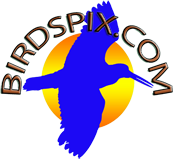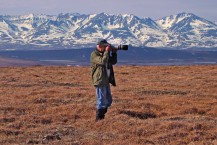May 30 – June 11: The trip to Arizona and California (and St. Louis, MO) produced twelve (numbered) new species photographed, as well as new and better photos of numerous previously seen species. Nancy and I flew into Phoenix on May 29 and stayed in Goodyear overnight so as to be close to the LeConte’s Thrasher site near Buckeye first thing in the morning. For anyone looking for this species, the Best Western in Goodyear is particularly recommended – clean, comfortable, reasonable, and conveniently located close to the highway. Remember that Arizona has no daylight saving time, so sunrise is an hour early – around 5:15 AM!
I set the alarm for 4:30 AM and was at the search area by 5:30, just after sunrise. The sparsely vegetated desert site that thrashers favor is located some eight miles west of Buckeye at the intersection of Baseline Road and Salome Highway. The first bird I saw was Abert’s Towhee, and Black-tailed Gnatcatchers were calling from the shrubbery close to the road. It took twenty minutes of walking before a thrasher was heard and spotted 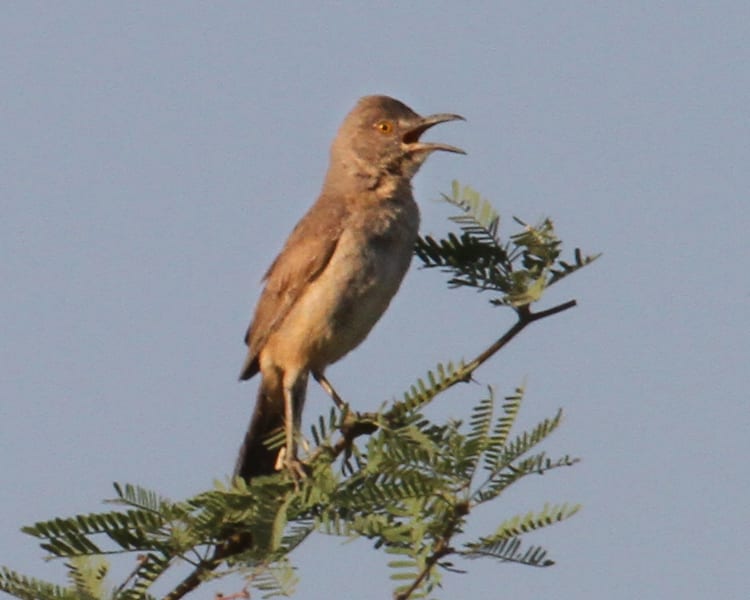 perched at the top of a distant small tree, but this first one turned out to be a Bendire’s. Then, after a full hour of systematically scouring the area, suddenly there was some furtive movement under a scrubby shrub, and there at last was the secretive LeConte’s Thrasher (1). This species tends to walk or run in the opposite direction when
perched at the top of a distant small tree, but this first one turned out to be a Bendire’s. Then, after a full hour of systematically scouring the area, suddenly there was some furtive movement under a scrubby shrub, and there at last was the secretive LeConte’s Thrasher (1). This species tends to walk or run in the opposite direction when 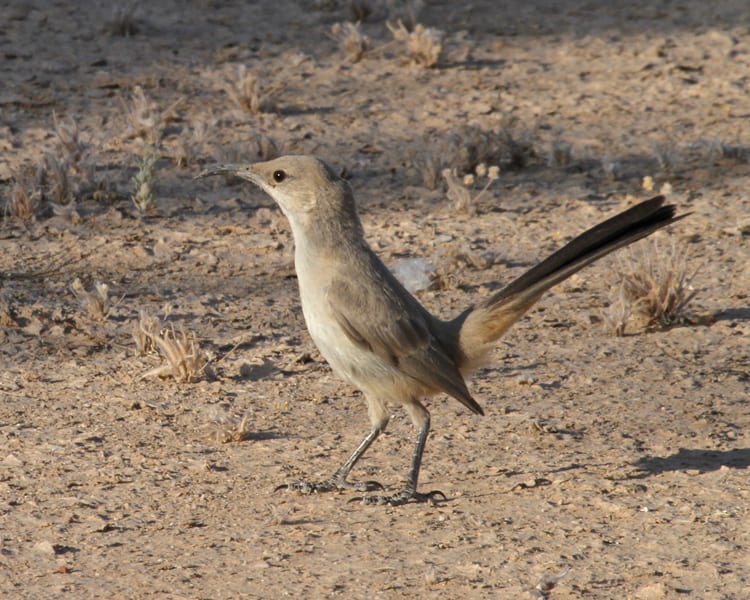 approached, plus for good photography one also needs to get into position with the sun behind, so it took some careful methodical maneuvering and patience, but in the end this bird provided some nice poses. Later I came upon three more that appeared to be a family unit of a mother and two immatures.
approached, plus for good photography one also needs to get into position with the sun behind, so it took some careful methodical maneuvering and patience, but in the end this bird provided some nice poses. Later I came upon three more that appeared to be a family unit of a mother and two immatures.
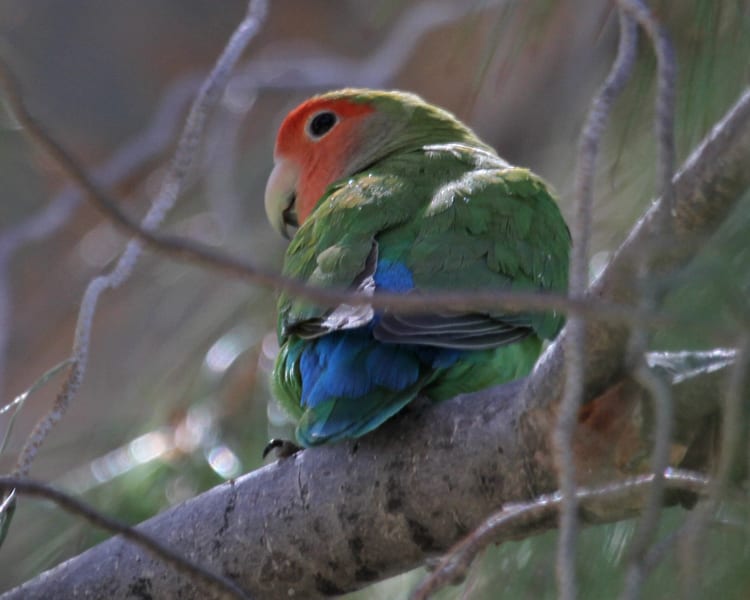 After breakfast back at the Best Western, the next target was Rosy-faced Lovebird (2). There are now some estimated 2500 of these endearing little parrots established in the greater Phoenix metropolis and I had several spots in mind to look for them, but as it turned out we found them easily at Encanto Park, the very first stop. They are quite vocal and easy to locate in the trees, and sometimes even on the ground. I counted nine, and there were likely more.
After breakfast back at the Best Western, the next target was Rosy-faced Lovebird (2). There are now some estimated 2500 of these endearing little parrots established in the greater Phoenix metropolis and I had several spots in mind to look for them, but as it turned out we found them easily at Encanto Park, the very first stop. They are quite vocal and easy to locate in the trees, and sometimes even on the ground. I counted nine, and there were likely more. 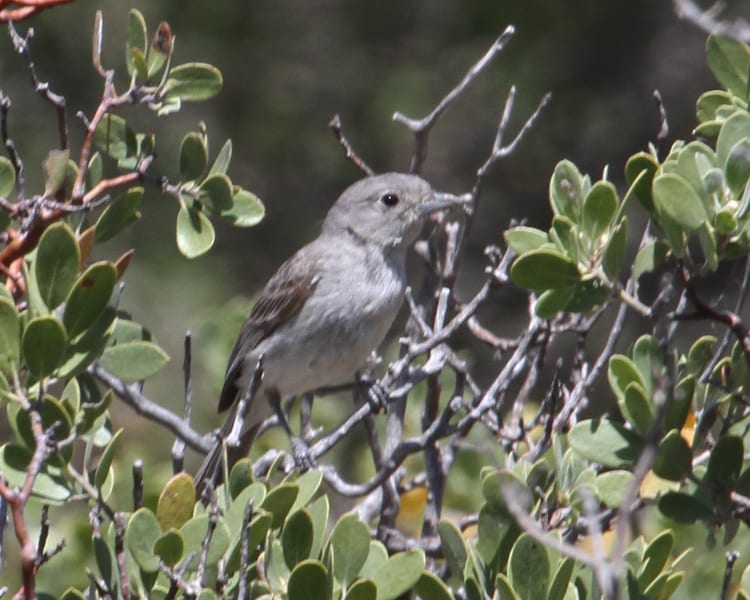 Next we drove east on US 60 up into the Tonto National Forest, just past Superior, to Oak Flat Campground to look for the elusive Gray Vireo (3). Here, as everywhere, early morning is best, and by now it was already midday and 100 degrees, and I hoped it wasn’t too late in the day, but one can’t be everywhere at sunrise, and some birds here were indeed still singing, although I did not hear any vireos right away. Vermilion Flycatchers cavorted along the road into the campground, Bushtits were active in the trees, and several Ash-throated Flycatchers called from the treetops. It took some exploring and a climb up a rocky hillside before I finally heard two Gray Vireos. This bird is not only difficult to find, but also difficult to photograph as it tends to move continually, remains partially hidden by leafy foliage, and rarely perches in the open. Also on the hillside were Phainopepla, Spotted Towhee, and Black-throated Sparrow.
Next we drove east on US 60 up into the Tonto National Forest, just past Superior, to Oak Flat Campground to look for the elusive Gray Vireo (3). Here, as everywhere, early morning is best, and by now it was already midday and 100 degrees, and I hoped it wasn’t too late in the day, but one can’t be everywhere at sunrise, and some birds here were indeed still singing, although I did not hear any vireos right away. Vermilion Flycatchers cavorted along the road into the campground, Bushtits were active in the trees, and several Ash-throated Flycatchers called from the treetops. It took some exploring and a climb up a rocky hillside before I finally heard two Gray Vireos. This bird is not only difficult to find, but also difficult to photograph as it tends to move continually, remains partially hidden by leafy foliage, and rarely perches in the open. Also on the hillside were Phainopepla, Spotted Towhee, and Black-throated Sparrow.
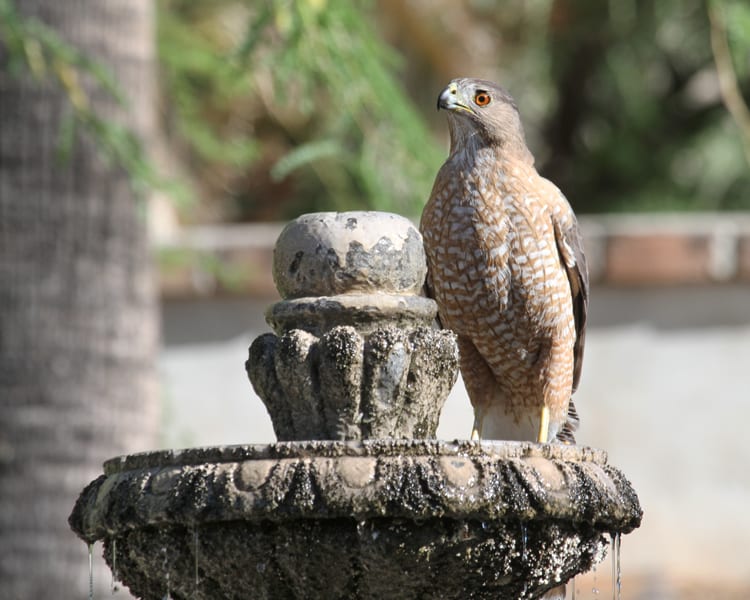 Encouraged at having found all three of our target species in the Phoenix environs, we moved on to Tucson and arrived at 5:30 PM at the El Presidio B&B. This charming inn in the middle of Tucson gets our highest recommendation. Behind the privacy of its gated walls, hostess Patti Toci has lovingly restored this charming old hacienda into a welcoming oasis, with its courtyard garden of original cobblestones, myriad flowering plants, vines, and trees, and a beautiful authentic three-tiered Mexican fountain as its centerpiece. We had barely poked our heads in through the gate when, almost as if to greet us, a Cooper’s Hawk landed on the top tier of the fountain for an evening drink.
Encouraged at having found all three of our target species in the Phoenix environs, we moved on to Tucson and arrived at 5:30 PM at the El Presidio B&B. This charming inn in the middle of Tucson gets our highest recommendation. Behind the privacy of its gated walls, hostess Patti Toci has lovingly restored this charming old hacienda into a welcoming oasis, with its courtyard garden of original cobblestones, myriad flowering plants, vines, and trees, and a beautiful authentic three-tiered Mexican fountain as its centerpiece. We had barely poked our heads in through the gate when, almost as if to greet us, a Cooper’s Hawk landed on the top tier of the fountain for an evening drink.
The following morning, May 31, I was fortunate to join company with Matt VanWallene and Fraser Brooks who picked me up at the B&B at 5:30 AM so we could be at Miller Canyon in the Huachuca Mountains by 6:30. We noted seven Red-tailed and three Swainson’s-Hawks on the poles along Route 90, and a singing Plumbeous Vireo on the 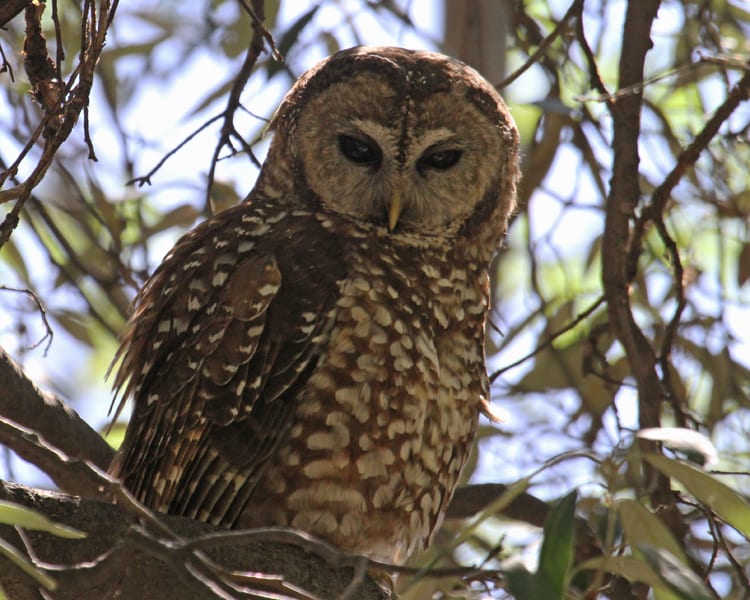 lower canyon road leading up to Beatty’s Guest Ranch. On the rocks around the guest house were a family of Rock Wrens, and the yard contained a number of domestic Helmeted Guineafowl. We purposely passed up the hummingbird feeders until later, and wasted no time starting up the canyon trail. We were greeted right away by a pair of Sulphur-bellied Flycatchers, but the main attraction on this trail is the uncommon Spotted Owl (4). We actually found the entire family –
lower canyon road leading up to Beatty’s Guest Ranch. On the rocks around the guest house were a family of Rock Wrens, and the yard contained a number of domestic Helmeted Guineafowl. We purposely passed up the hummingbird feeders until later, and wasted no time starting up the canyon trail. We were greeted right away by a pair of Sulphur-bellied Flycatchers, but the main attraction on this trail is the uncommon Spotted Owl (4). We actually found the entire family – 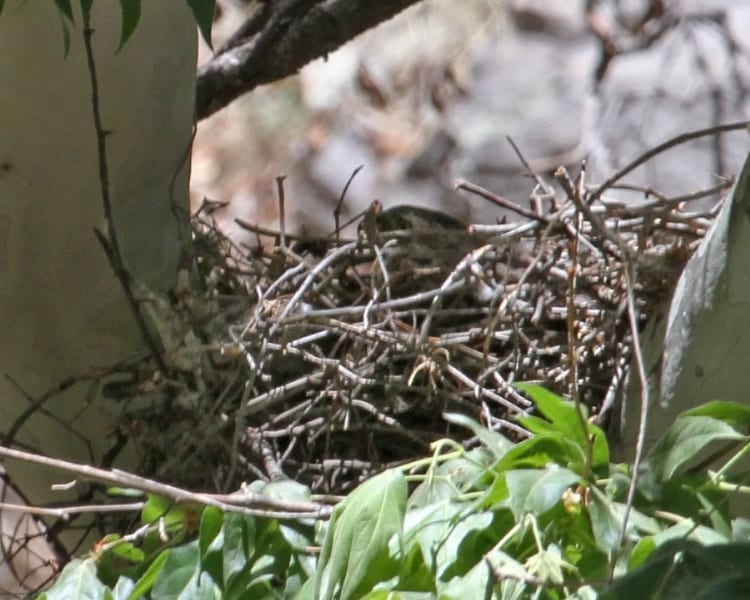 male, female, and the nest hole with two owlets poking their heads out, and spent some quality time admiring them and, as unobtrusively as possible, getting some photos (without flash). Further up the trail, just down from the old mine, we
male, female, and the nest hole with two owlets poking their heads out, and spent some quality time admiring them and, as unobtrusively as possible, getting some photos (without flash). Further up the trail, just down from the old mine, we 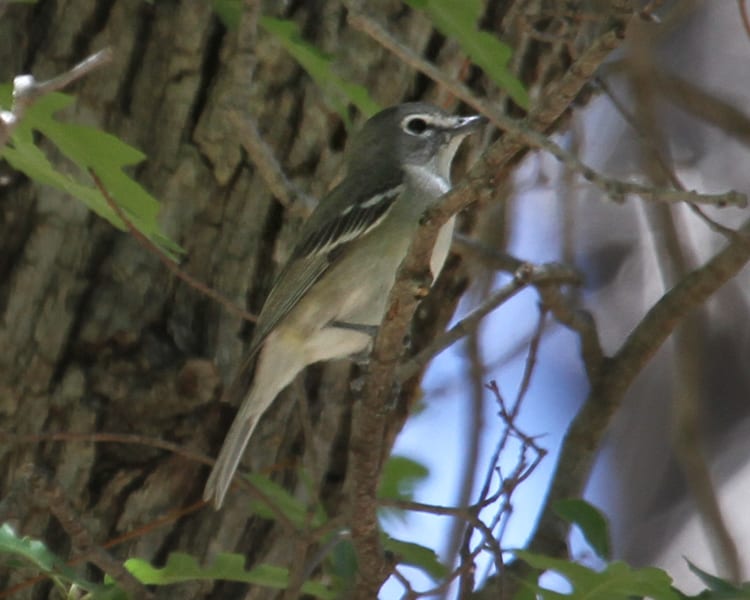 were fortunate to observe a female Northern Goshawk (5) nestled in her nest high up in a large sycamore tree. This trail is also a particularly good spot for Red-faced Warblers, Painted Redstarts, and Western Tanagers. We even added a pair of Cassin’s Vireos on this trail, surprising in that the expected species here would be Plumbeous.
were fortunate to observe a female Northern Goshawk (5) nestled in her nest high up in a large sycamore tree. This trail is also a particularly good spot for Red-faced Warblers, Painted Redstarts, and Western Tanagers. We even added a pair of Cassin’s Vireos on this trail, surprising in that the expected species here would be Plumbeous.
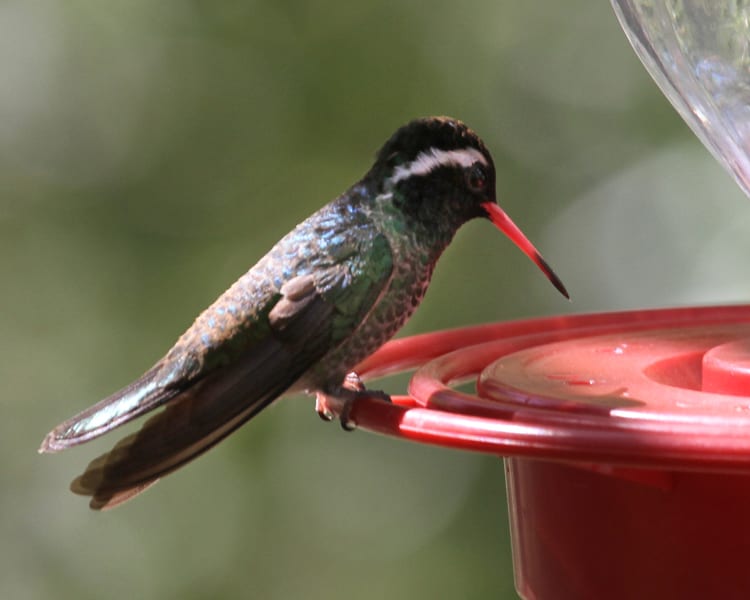 After the somewhat grueling climb in the 102 degree heat, we spent some time regrouping by the Hummingbird feeders watching six species including Magnificent, Broad-billed, Broad-tailed, Black-chinned, Costa’s, and the uncommon White-eared.
After the somewhat grueling climb in the 102 degree heat, we spent some time regrouping by the Hummingbird feeders watching six species including Magnificent, Broad-billed, Broad-tailed, Black-chinned, Costa’s, and the uncommon White-eared.
We spent the late afternoon into the evening at Madera Canyon, at nightfall joining a host of other birders at the Proctor Road campground where a Buff-collared Nightjar had been reported for the past two weeks. We did get to hear (although not see) this uncommon Mexican visitor, as well as a Common Poorwill and a Mexican Whip-poor-will, and we observed a number of Lesser Nighthawks just after sunset.
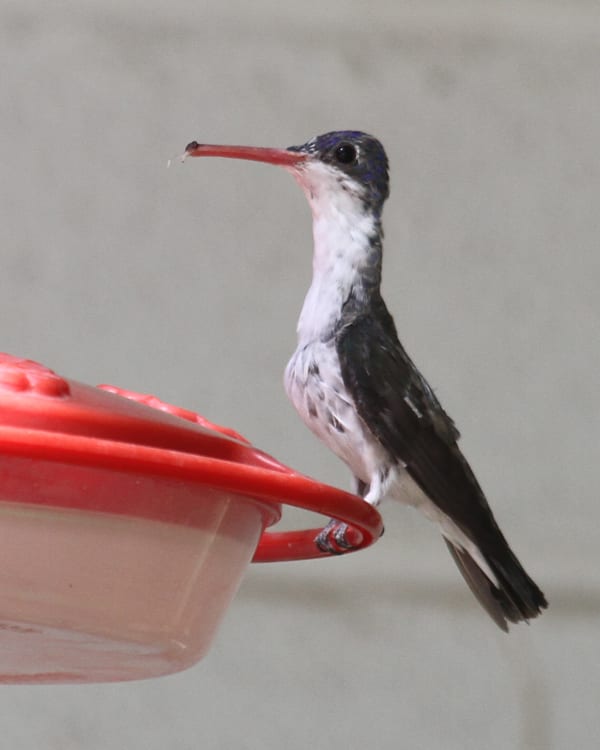 The following morning, June 1, Fraser and Matt again picked me up early, this time for Patagonia. We started at the Patagonia Lake State Park, a site where Yellow-breasted Chat is the most common warbler (we counted at least six). Next was a stop at the well-known Patagonia roadside rest stop where the ever-reliable Thick-billed Kingbird and a male Phainopepla each perched prominently for us. No visit to Patagonia is complete without some time at the Paton’s house, where myriad species come to refresh themselves at the fountain, but the main attraction is the Violet-crowned Hummingbird.
The following morning, June 1, Fraser and Matt again picked me up early, this time for Patagonia. We started at the Patagonia Lake State Park, a site where Yellow-breasted Chat is the most common warbler (we counted at least six). Next was a stop at the well-known Patagonia roadside rest stop where the ever-reliable Thick-billed Kingbird and a male Phainopepla each perched prominently for us. No visit to Patagonia is complete without some time at the Paton’s house, where myriad species come to refresh themselves at the fountain, but the main attraction is the Violet-crowned Hummingbird. 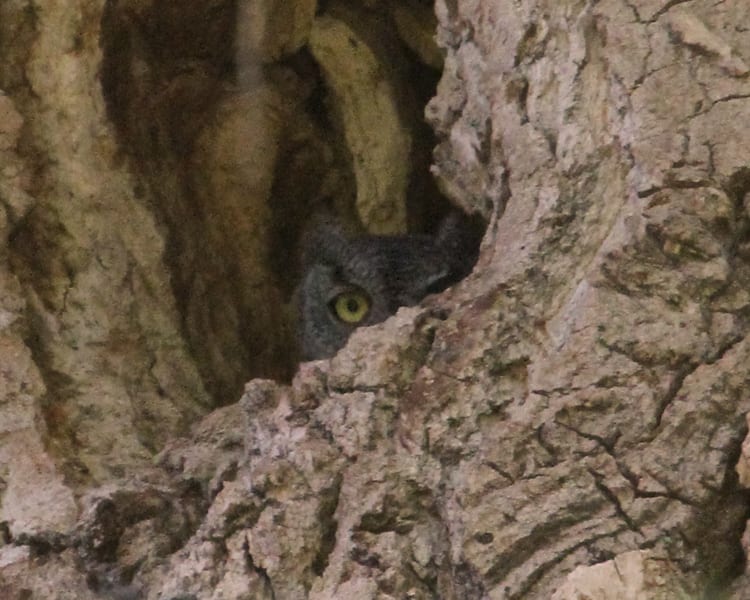 We finished the afternoon at the Patagonia Sonoita Creek Preserve where Matt knew the location of a Western Screech-Owl nest, and we got to observe a baby Western Screech-Owl (6) peering out of its hole. We waited until nearly 6 PM, hoping to see the parents return, but finally left without having seen them.
We finished the afternoon at the Patagonia Sonoita Creek Preserve where Matt knew the location of a Western Screech-Owl nest, and we got to observe a baby Western Screech-Owl (6) peering out of its hole. We waited until nearly 6 PM, hoping to see the parents return, but finally left without having seen them.
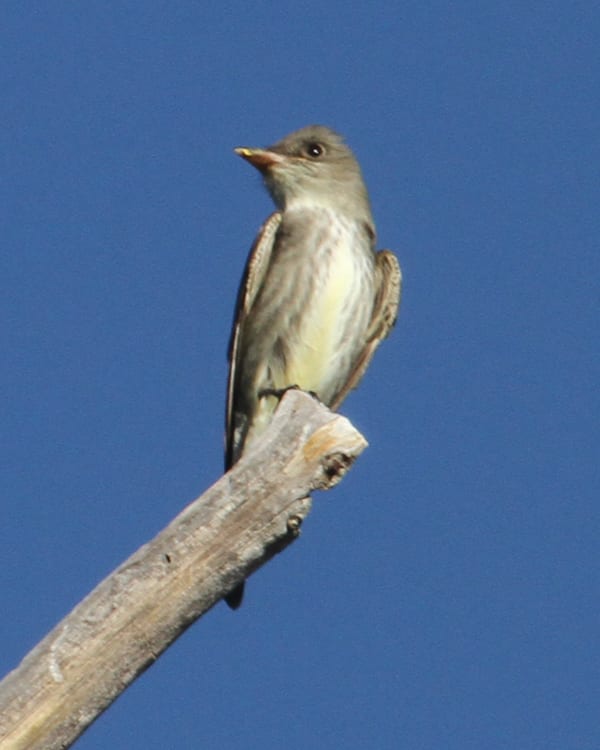 On June 2, the three of us this time headed up Mt. Lemmon, just to the northeast of Tucson, hoping to find a life Greater Pewee. (7) Melody Kehl had suggested a spot near the 17 mile marker, so we parked at a turnout there and began searching up and down along the roadside. I spotted a bird perched at the very top of a dead snag, which turned out to be a colorful Violet-green Swallow, a bird usually seen only in rapid flight and thus hard to get a photo of. I snapped away, and as I usually do, took a moment
On June 2, the three of us this time headed up Mt. Lemmon, just to the northeast of Tucson, hoping to find a life Greater Pewee. (7) Melody Kehl had suggested a spot near the 17 mile marker, so we parked at a turnout there and began searching up and down along the roadside. I spotted a bird perched at the very top of a dead snag, which turned out to be a colorful Violet-green Swallow, a bird usually seen only in rapid flight and thus hard to get a photo of. I snapped away, and as I usually do, took a moment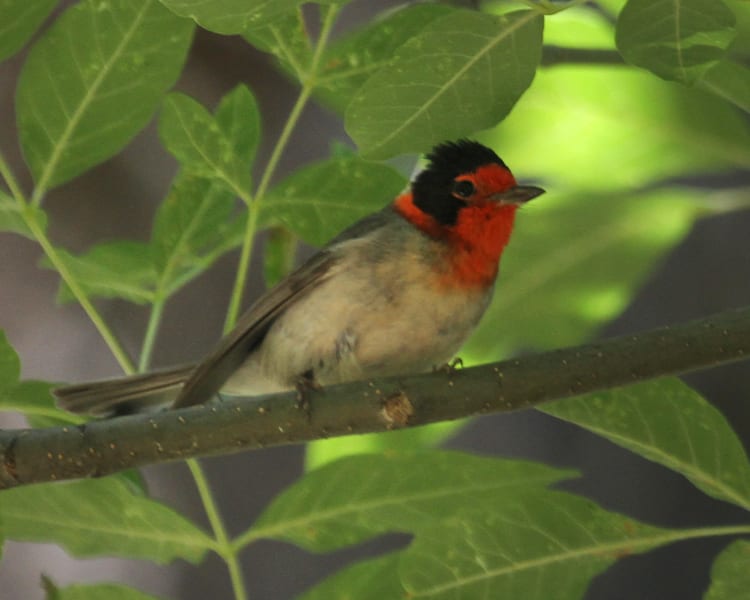 to look down at the images on the camera and quickly delete the bad ones. When I then raised the camera to take some more shots, to my amazement the
to look down at the images on the camera and quickly delete the bad ones. When I then raised the camera to take some more shots, to my amazement the 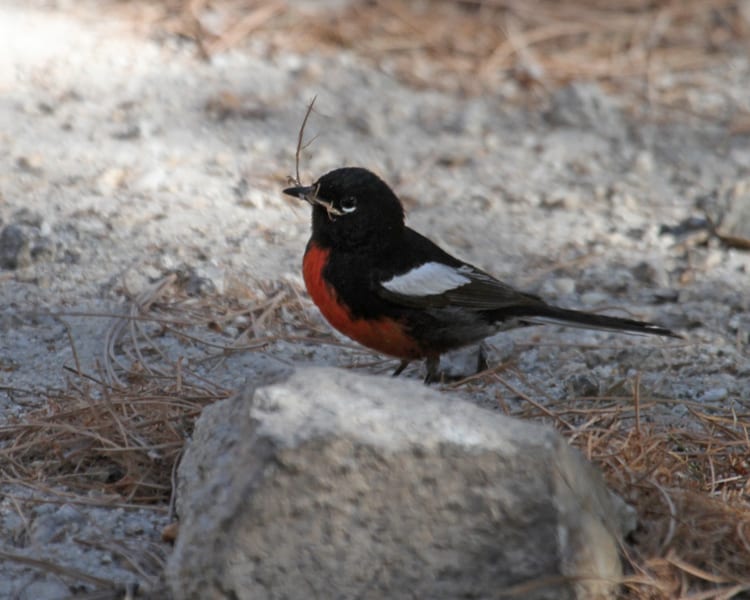 swallow had morphed into, of all things, the Greater Pewee which was now prominently perched in the indentical spot – one of those inexplicable and indelible “eureka” moments.
swallow had morphed into, of all things, the Greater Pewee which was now prominently perched in the indentical spot – one of those inexplicable and indelible “eureka” moments.
Next we moved up to the 19 mile marker and Incinerator Ridge where there were several each of Red-faced Warblers and Painted Redstarts, including one building a nest at the side of the road under the berm, and a Cordilleran Flycatcher. That afternoon, although Matt and Fraser unfortunately had to return to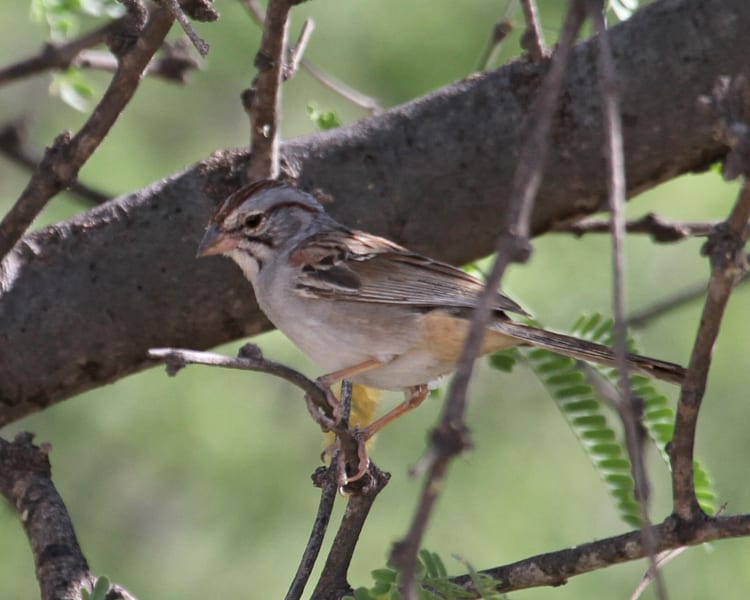 Tucson and couldn’t join us, I met Melody Kehl in Green Valley for a return visit to California Gulch which I had visited once before with her in 2009. The road to the Gulch featured Rufous-winged and Botteri’s Sparrow, Phainopepla, and a trio of Mexican Jays. At California Gulch, unlike last time, the Five-striped Sparrow was hard to find although we finally did
Tucson and couldn’t join us, I met Melody Kehl in Green Valley for a return visit to California Gulch which I had visited once before with her in 2009. The road to the Gulch featured Rufous-winged and Botteri’s Sparrow, Phainopepla, and a trio of Mexican Jays. At California Gulch, unlike last time, the Five-striped Sparrow was hard to find although we finally did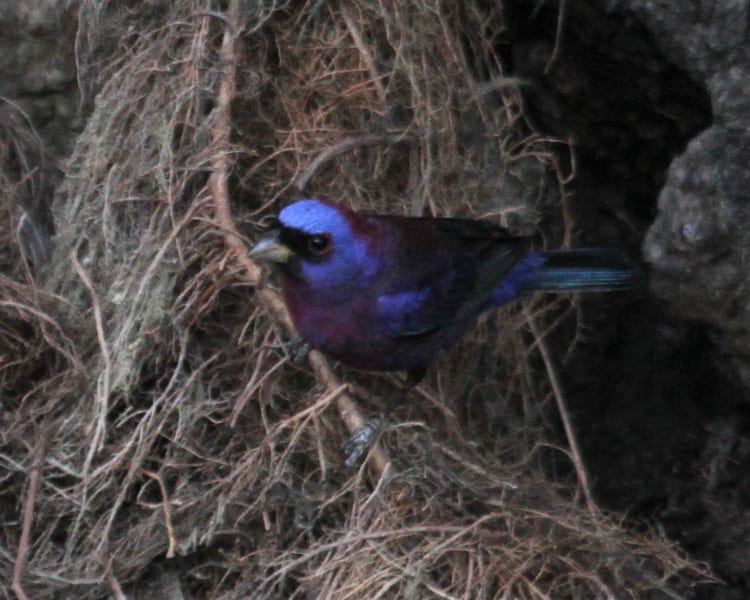 see one, but not in the open enough for a photo. We did have five different Varied Buntings including one that was quite cooperative, and a Gray Hawk circled overhead nicely lighted by the setting sun. At the nearby Oro Blanco Mine we had a Hooded Oriole and a Summer Tanager, but the highlight was driving along the rutted road at nightfall
see one, but not in the open enough for a photo. We did have five different Varied Buntings including one that was quite cooperative, and a Gray Hawk circled overhead nicely lighted by the setting sun. At the nearby Oro Blanco Mine we had a Hooded Oriole and a Summer Tanager, but the highlight was driving along the rutted road at nightfall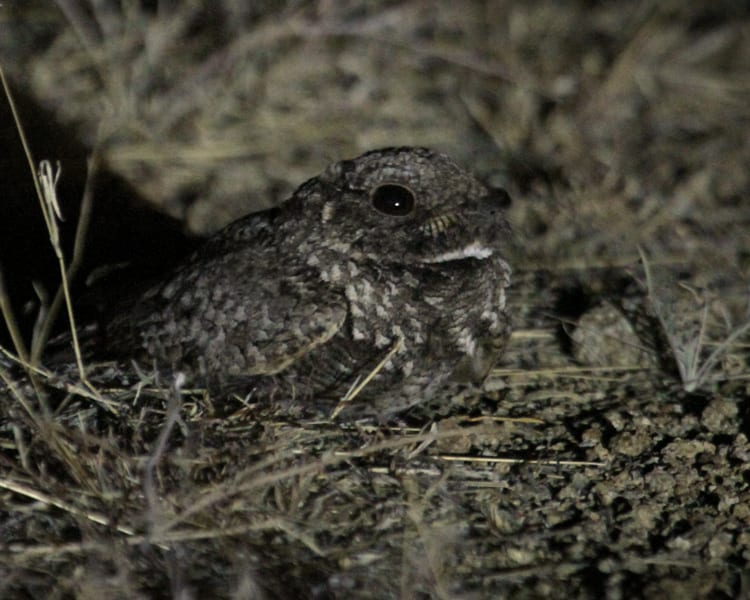 looking for the eye shine of Common Poorwills (8) along the roadside. We saw four, and I found it possible to photograph one without flash (thereby avoiding the unsightly red-eye reflex) using an ISO setting of 3200 and the light of just the car headlights and a flashlight. A Common Poorwill will allow quite close approach while remaining stock still.
looking for the eye shine of Common Poorwills (8) along the roadside. We saw four, and I found it possible to photograph one without flash (thereby avoiding the unsightly red-eye reflex) using an ISO setting of 3200 and the light of just the car headlights and a flashlight. A Common Poorwill will allow quite close approach while remaining stock still.
On June 3, birding went on the back burner for a sojourn to Sedona and the next day on to the Grand Canyon south rim. The scenery was king for two days, and although I had hoped to see a California Condor at the Grand Canyon, we never did see one.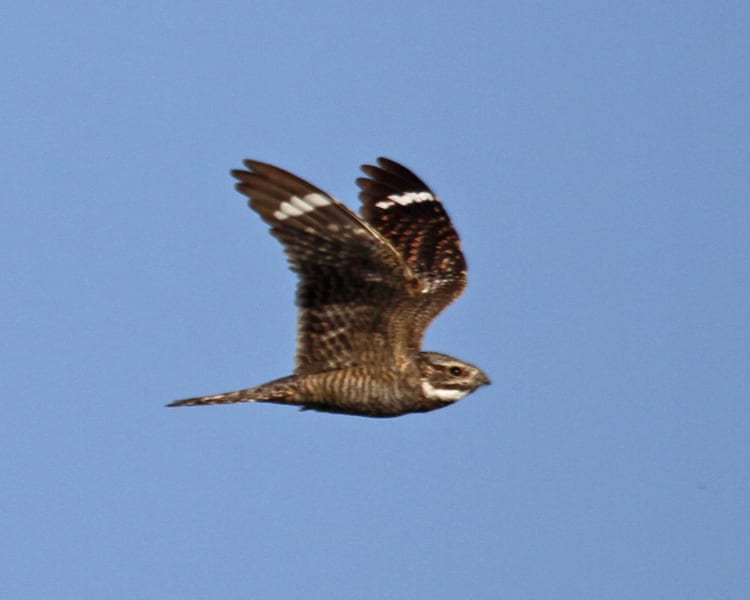 We made it back to Phoenix late on June 5 for a 10:15 AM flight to Los Angeles the next day, but there was still time for one last outing in Arizona. I met Matt VanVallene again at 5:30 AM at the home of Jay Miller in Mesa, and Vicki Hire graciously completed the foursome. Jay led us to a spot he discovered along the Salt River where each morning Lesser Nighthawks (9) feast on insects over the river in the early morning sunlight, providing a sparkling photography opportunity. We were in place at the river bank from 6 AM, and the first nighthawk appeared at precisely 6:29, after which we must have seen close to two dozen. Many thanks to Jay for sharing this serene spot with us and providing an especially rewarding and memorable experience. I wished I could have stayed longer, but I had to leave for the airport.
We made it back to Phoenix late on June 5 for a 10:15 AM flight to Los Angeles the next day, but there was still time for one last outing in Arizona. I met Matt VanVallene again at 5:30 AM at the home of Jay Miller in Mesa, and Vicki Hire graciously completed the foursome. Jay led us to a spot he discovered along the Salt River where each morning Lesser Nighthawks (9) feast on insects over the river in the early morning sunlight, providing a sparkling photography opportunity. We were in place at the river bank from 6 AM, and the first nighthawk appeared at precisely 6:29, after which we must have seen close to two dozen. Many thanks to Jay for sharing this serene spot with us and providing an especially rewarding and memorable experience. I wished I could have stayed longer, but I had to leave for the airport.
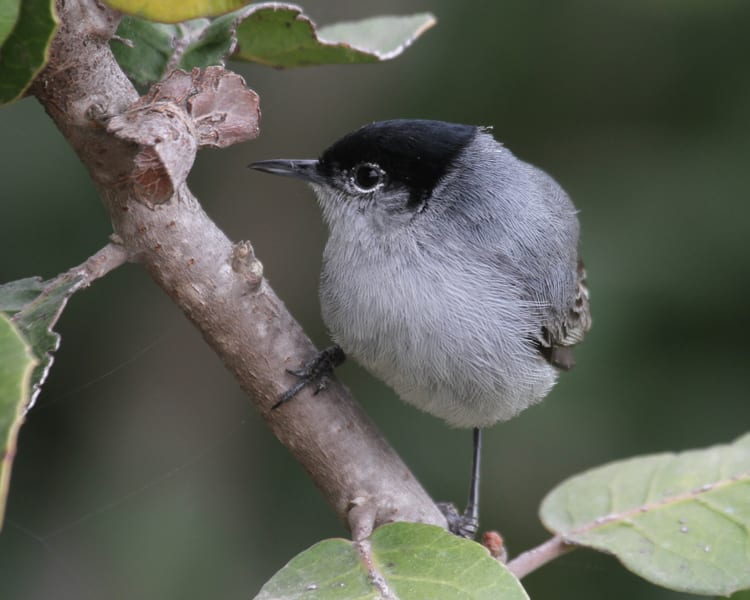 We arrived in Los Angeles just after noon, but the Hertz car rental center at LAX was a complete zoo and we didn’t get out of there until well after 2 PM. We made a beeline down the 405 to the Harbor Freeway to its end in Long Beach and quickly found our way to Palos Verdes Drive South and the Ocean Trail spot to look for a California Gnatcatcher (10). Not twenty yards down the trail adjoining the Trump National Golf Course, the very first bird I saw was indeed the sought after gnatcatcher, a sassy little thing that perches and scolds right out in the open. That left time for a stop at Salt Lake Park in Huntington Park in hopes of finding a Spotted Dove, but despite over
We arrived in Los Angeles just after noon, but the Hertz car rental center at LAX was a complete zoo and we didn’t get out of there until well after 2 PM. We made a beeline down the 405 to the Harbor Freeway to its end in Long Beach and quickly found our way to Palos Verdes Drive South and the Ocean Trail spot to look for a California Gnatcatcher (10). Not twenty yards down the trail adjoining the Trump National Golf Course, the very first bird I saw was indeed the sought after gnatcatcher, a sassy little thing that perches and scolds right out in the open. That left time for a stop at Salt Lake Park in Huntington Park in hopes of finding a Spotted Dove, but despite over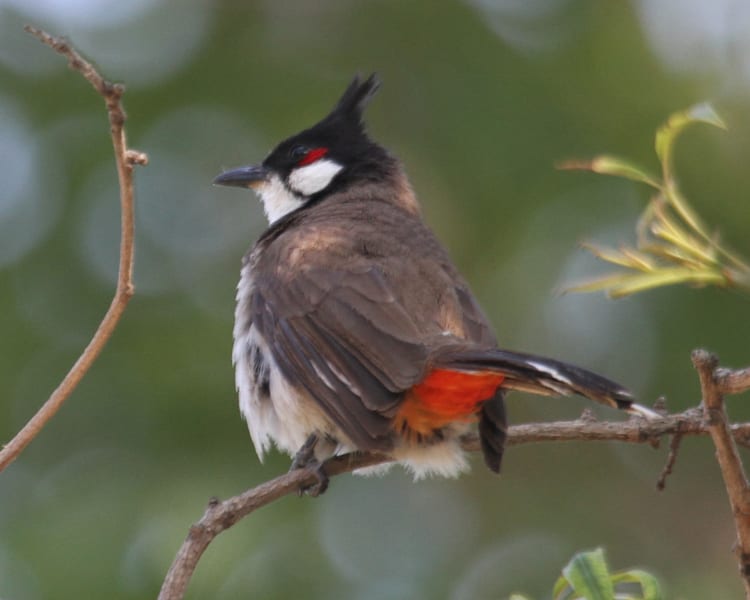 an hour of searching, the dove was a no-show, as it was again, to my disappointment, the following morning, June 7.
an hour of searching, the dove was a no-show, as it was again, to my disappointment, the following morning, June 7.
We spent the afternoon of June 7 at the Los Angeles County Arboretum in Arcadia, where there is a large colony of vocal resident Red-whiskered Bulbuls (I counted at least eight). This is actually a much better place to see this species than in Kendall, FL, where the birds are scattered in residential neighborhoods and can be very unreliable and difficult to find. 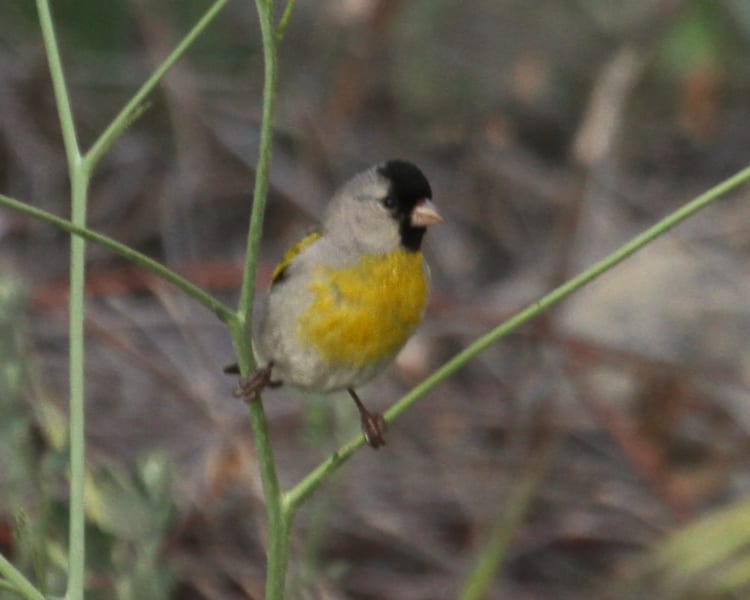 We stayed the four nights on Colorado Blvd. in lovely Pasadena, where the many boulevards with venerable homes and purple flowering Jacaranda trees are magnificent. My main target bird for this area was Lawrence’s Goldfinch (11), a species that had turned into something of a nemesis, having missed it in Santa Barbara, Mount Pinos, and Pinnacles National Monument on previous California visits. On June 8 we checked a number of stops along the Angeles National Highway in the San Gabriel Mountains, all the way up to Buckhorn Campground, and heard Lawrence’s at five different locations without ever seeing the bird. Persistence finally paid off however the next morning, when I found three male Lawrence’s Goldfinches (10) at 2600 feet at the very first place I stopped along the mountain highway, and I made it back for breakfast by 9 AM. The rest of the day was in Hollywood visiting a dear friend, and a side trip up to Griffith Park and the planetarium show. We checked out Salt Lake Park one last time on the way back to LAX on June 10, and this time I heard three Spotted Doves – two around the tennis courts at the north end, and one more in the residential neighborhood across the street to the north, but they remained hidden in the trees and I never managed to see even one of them.
We stayed the four nights on Colorado Blvd. in lovely Pasadena, where the many boulevards with venerable homes and purple flowering Jacaranda trees are magnificent. My main target bird for this area was Lawrence’s Goldfinch (11), a species that had turned into something of a nemesis, having missed it in Santa Barbara, Mount Pinos, and Pinnacles National Monument on previous California visits. On June 8 we checked a number of stops along the Angeles National Highway in the San Gabriel Mountains, all the way up to Buckhorn Campground, and heard Lawrence’s at five different locations without ever seeing the bird. Persistence finally paid off however the next morning, when I found three male Lawrence’s Goldfinches (10) at 2600 feet at the very first place I stopped along the mountain highway, and I made it back for breakfast by 9 AM. The rest of the day was in Hollywood visiting a dear friend, and a side trip up to Griffith Park and the planetarium show. We checked out Salt Lake Park one last time on the way back to LAX on June 10, and this time I heard three Spotted Doves – two around the tennis courts at the north end, and one more in the residential neighborhood across the street to the north, but they remained hidden in the trees and I never managed to see even one of them.
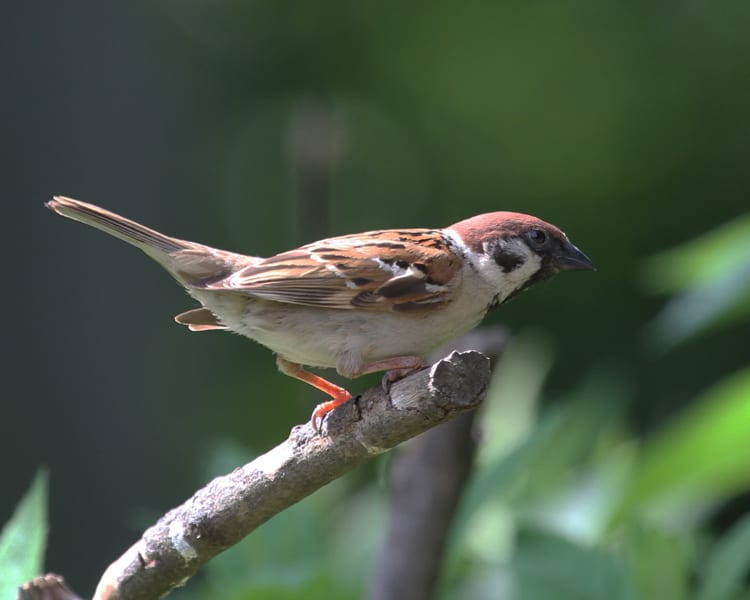 The trip concluded with an overnight stay in St, Louis, MO, where I had planned to visit with my good friend Bob Mustell, whom I had met on last year’s Nome and Gambell trip, to look for the Eurasian Tree Sparrow, (12) but Bob had a family priority and couldn’t make it. Instead Nancy and I were fortunate to enjoy the gracious hospitality of Mark Paradise, who welcomed us to his home and backyard where Eurasian Tree Sparrows are regulars, and where, for a refreshing change, I was able to photograph from a comfortable chair instead of a steep, rocky mountain trail. A little later I found another Eurasian Tree Sparrow, along with two Dickcissels, at a second spot not too far from the airport. Again, thanks to Matt VanWallene, Fraser Brooks, Jay Miller, and Mark Paradise for their warm welcome and comeradery, and to Melody Kehl for her unique expertise.
The trip concluded with an overnight stay in St, Louis, MO, where I had planned to visit with my good friend Bob Mustell, whom I had met on last year’s Nome and Gambell trip, to look for the Eurasian Tree Sparrow, (12) but Bob had a family priority and couldn’t make it. Instead Nancy and I were fortunate to enjoy the gracious hospitality of Mark Paradise, who welcomed us to his home and backyard where Eurasian Tree Sparrows are regulars, and where, for a refreshing change, I was able to photograph from a comfortable chair instead of a steep, rocky mountain trail. A little later I found another Eurasian Tree Sparrow, along with two Dickcissels, at a second spot not too far from the airport. Again, thanks to Matt VanWallene, Fraser Brooks, Jay Miller, and Mark Paradise for their warm welcome and comeradery, and to Melody Kehl for her unique expertise.
